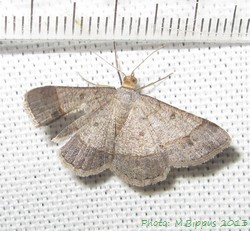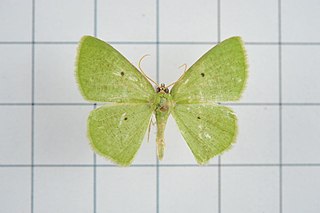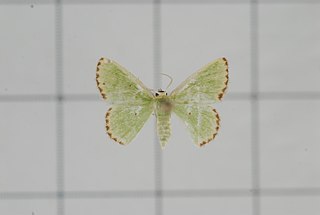
Homona coffearia, the tea tortrix or camellia tortrix, is a moth of the family Tortricidae. The species was first described by Nietner in 1861. It is widely distributed in the Oriental region.

Europlema desistaria is a species of moth of the family Uraniidae first described by Francis Walker in 1861. It is found in India, Sri Lanka, Myanmar, Thailand, Taiwan, Borneo, Sulawesi, Flores and Queensland.
Scopula emissaria is a moth of the family Geometridae. It was described by Francis Walker in 1861. It is found in India, Sri Lanka, Myanmar, Vietnam, China, Korea, Japan, the Philippines, Sumatra, Java, Wallacea and Australia.

Chiasmia normata is a moth in the family Geometridae first described by Francis Walker in 1861. It is found throughout of subtropical Africa and Asia, from India, Japan, Taiwan, Sri Lanka. to the Philippines and in Australia.

Pseudomicronia is a genus of moths in the family Uraniidae.

Aplochlora vivilaca is a moth of the family Geometridae first described by Francis Walker in 1861. It is found in Sri Lanka, Indian subregion, Taiwan, Borneo and Sulawesi.
Comostola chlorargyra is a moth of the family Geometridae first described by Francis Walker in 1861. It is found in Sri Lanka, the Indian subregion, the Andaman Islands, Borneo, Java, the Philippines, Sulawesi and Australia.
Cyclothea disjuncta is a moth of the family Geometridae first described by Francis Walker in 1861. It is found in Sri Lanka.

Eucrostes disparata is a moth of the family Geometridae first described by Francis Walker in 1861. It is found in Sri Lanka, Ethiopia, Taiwan, Japan and Australia.
Eucyclodes divapala is a moth of the family Geometridae first described by Francis Walker in 1861. It is found in Sri Lanka, as well as Taiwan.

Eucyclodes semialba is a moth of the family Geometridae first described by Francis Walker in 1861. It is found in Sri Lanka, the north-east Himalayas of India, Myanmar and Sundaland.
Idaea marcidaria is a moth of the family Geometridae first described by Francis Walker in 1861. It is found in Sri Lanka, Myanmar, China, Taiwan, Singapore and Borneo.
Plutodes transmutata is a moth of the family Geometridae first described by Francis Walker in 1861. It is found in India, Nepal and probably in Sri Lanka.
Probithia obstataria is a moth of the family Geometridae first described by Francis Walker in 1861. It is found in Sri Lanka and Australia.
Dysaethria conflictaria, or Epiplema conflictaria, is a moth of the family Uraniidae first described by Francis Walker in 1861. It is found in Indo-Australian tropics of India, Sri Lanka, Thailand, Papua New Guinea, the Solomon Islands and Australia.
Dysaethria rhagavata is a moth of the family Uraniidae first described by Francis Walker in 1861. It is found in Sri Lanka.
Pseudomicronia fraterna is a moth of the family Uraniidae. It is found in Sri Lanka.

Hipoepa biasalis is a moth of the family Noctuidae first described by Francis Walker in 1859. It is found in Oriental tropics of India and Sri Lanka to Taiwan, Sumatra, Borneo, the Philippines and Sulawesi.
Enispa oblataria is a moth of the family Erebidae first described by Francis Walker in 1861. It is found in Sri Lanka.

Micraeschus elataria is a moth of the family Erebidae first described by Francis Walker in 1861. It is found in Sri Lanka, Taiwan, Peninsular Malaysia, Singapore, Java and Borneo.










